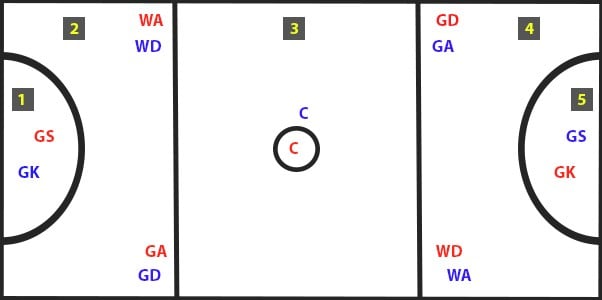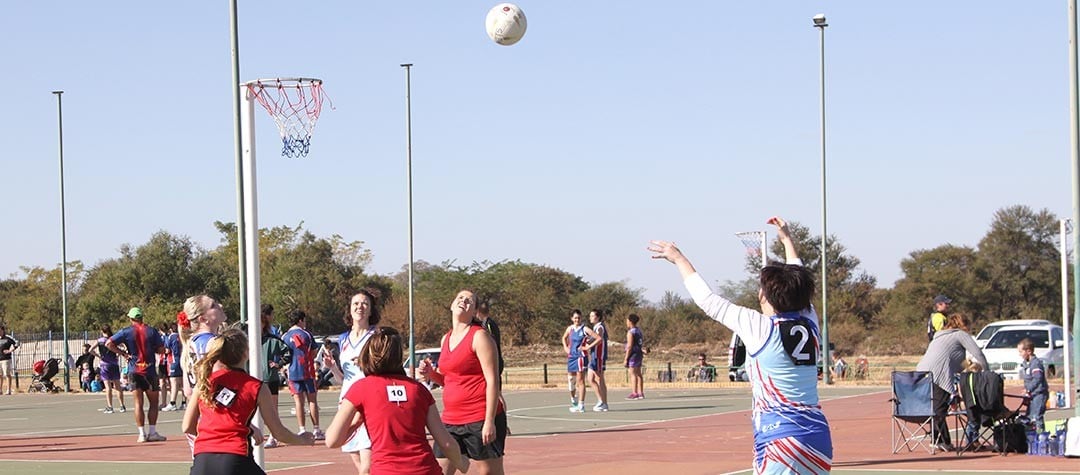Netball is a fast-paced sport that can appear complicated to a complete beginner, but once you’ve got to grip with the rules, the game will become easy to follow. Here’s an overview of the rules of netball to help you understand the game better.
Playing positions
Each team is made up of seven players, who play one of the positions listed in the table. The diagram below also shows a netball court and where each position stands during a centre pass. Each position is only allowed in certain areas of the court - as explained below.
| Position | Court Area (Blue) | Court Area (Red) |
| Goal Keeper - GK | 1 & 2 | 4 & 5 |
| Goal Defence - GD | 1, 2 & 3 | 3, 4 & 5 |
| Wing Defence - WD | 2 & 3 | 3 & 4 |
| Centre - C | 2, 3 & 4 | 2, 3 & 4 |
| Wing Attack - WA | 3 & 4 | 2 & 3 |
| Goal Attack - GA | 3, 4 & 5 | 1, 2 & 3 |
| Goal Shooter - GS | 4 & 5 | 1 & 2 |

How to play
A game of netball generally consists of four, 15 minute quarters, plus any injury time awarded by the referee.
Centre passes are taken alternatively by each team at the start of each quarter and once a goal has been scored.
One point is awarded for every goal. Only the Goal Attack (GA) and Goal Shooter (GS) from each team are allowed to score, and they must be completely inside the goal circle when they shoot.
Overview of the rules
Breaking a minor rule in netball leads to the opposition being awarded a free pass, which is a pass taken from the same spot where the infringement occurred.
Breaking a major netball rule is naturally considered to be more serious, and results in the opposition being awarded a penalty pass, which means the player who broke the rule must stand out of the way until the pass is taken. If a player gives away a penalty pass in the goal circle then the shooter can take a free shot at goal.
Major netball rules infringements
- Netball players cannot make physical contact with one another on the court.
- Defenders have to stand 3ft (0.9m) away from the player with the ball and can only attempt to win the ball back once it has been thrown into the air. They cannot attempt to knock it out of an opponent’s hands.
- Players can mark other players, even when they haven’t got the ball, but any physical contact results in a penalty pass being awarded.
- Even accidental contact will result in a penalty pass if a player has been ruled to have been unfairly hindered.
Minor netball rule infringements
Ball control
- When a netball player receives a pass they are not allowed to run with the ball or dribble with it.
- To gain control of the ball, a player can bat or bounce the ball once, but they cannot bat and bounce the ball, or do either more than once. It is also against the rules to push the ball into the air before batting or bouncing it.
- A player has to be standing in a stationary position before they can throw the ball.
Three-second rule in netball
- So that the game is played at a fast pace, netball players are given only three seconds to make a pass after catching the ball.
Making space in a netball match
- To give the opposition an opportunity to steal the ball, team members must leave enough room between themselves when passing so that an opponent would feasibly be able to move between them and intercept.
Netball footwork
If a player catches the ball with only one foot on the ground then that foot is called the landing foot. The player has a number of options:
- The player can step with the other foot, lift the landing foot, and throw the ball before the landing foot returns to the ground.
- The player can pivot on the landing foot and move the other foot any number of times, but are not allowed to hop on or lift the landing foot until they have thrown the ball.
- The player can also jump, switching from the landing foot to the other one, and then jump again to throw the ball.
- If a player has both feet on the floor when catching the ball, they can decide which foot will act as their landing foot.
- Breaking the footwork rule is called stepping and leads to the award of a free pass.
Netball court boundaries
- Each player is only allowed in a certain area of the court and if they step out of this area they are considered to be offside, even if they are not in possession of the ball.
- The ball must be handled in each third of the court, so a player cannot make a basketball-style long throw from the defensive third to the attacking third in an attempt to make a quick score.
- If the ball goes out of court, it is returned into play by a throw-in by the opposing team, which is taken from a point outside the line where the ball left the court.
Toss ups in netball
- Occasionally players will get tangled up when reaching for the ball at the same time and the umpire will be unable to decide who has possession. In these instances, the official will use a toss up to restart the game.
- In a toss up, the two players face each other while the umpire stands in between them. The umpire then throws the ball up (just to give smaller players a chance, no more than 2ft or 0.6m above the shoulder height of the shorter player) and both players try to catch it.
Picture Credit: Snap2Art / Shutterstock.com














